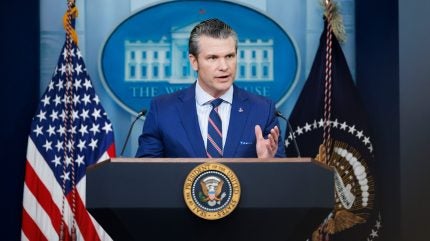
In yet further indication of the detachment of Washington from its old allies in Europe, it looks likely that US Secretary of Defense Pete Hegseth will miss the upcoming Ukraine Defense Contact Group (UDCG) meeting, due to take place next week.
The past 48 hours have given a series of clues as to this outcome, with a 2 April release from Nato’s press office stating that the UK and Germany would convene the UDCG at Nato’s headquarters in Brussels on 11 April.
Prior to the installation of the Trump administration in the White House, the UDCG had been chaired by former US Defense Secretary Lloyd J Austin.
Hegseth’s appearance at the last UDCG meeting on 12 February fired the first warning shots of a new World Order being written, one in which the US looks set to detach itself from Nato, and Europe, in favour of a budding friendship with Russia and a focus to counter China in the Indo-Pacific.
Immediately following the Nato release and its lack of a reference to any US participation, Army Technology approached the US Department of Defense (DoD) for confirmation as to whether a US delegation would be present at the Nato HQ meeting. The DoD did not respond.
Subsequent reporting by Defense News and CNN stated Hegseth was set to miss the key Ukraine meeting.
Then, on 4 April, the US DoD published a released stating that Secretary Hegseth would be departing the US “early next week” to participate in the 2025 Central American Security Conference (CENTSEC). The CENTSEC event is taking place in Panama from 8-10 April.
“The Secretary will meet with partner-nation senior civilian, military, and security leadership in a series of bilateral meetings that will drive ongoing efforts to strengthen our partnerships with Panama and other Central American nations toward our shared vision for a peaceful and secure Western Hemisphere,” the DoD spokesperson stated.
The DoD added that Hegseth would also travel to Eglin AFB to visit service members and command leadership at 7th Special Forces Group.
In what is either a sign of bilateral cooperation or a military power play by Washington, the timing of CENTSEC will also see the US military fighters and other aircraft, including a P-8 Poseidon submarine hunter, join the Ticonderoga-class guided missile cruisers USS Chosin and USS Normandy in a visit to Panama.
US has “utmost respect” for Panama’s sovereignty
A telling communiqué by the US embassy in Panama on 4 April stated that, as part of the CENTSEC event, “bilateral cooperation activities” had been authorised by the Panamanian government and would be carried out “with the utmost respect for the Panamanian people and Panama’s sovereignty”.
In recent weeks the US administration has made claims of its intention to seize the Panama Canal, as it seeks to re-establish its influence in Central and South America.
Fellow GlobalData news outlet Ship Technology reported at the end of March that the canal was becoming a proxy for the escalating trade war between China and the US.
Beijing’s imposition of counter-tariffs on 4 April in response to the Trump administration’s placing tariffs on China and dozens of other countries further indicates the need for Washington to secure strategic locations such as the Panama Canal.
In the event of any standoff to military escalation with Beijing, Washington would seek to use the Panama Canal to move additional naval forces stationed on the east coast over the west.


